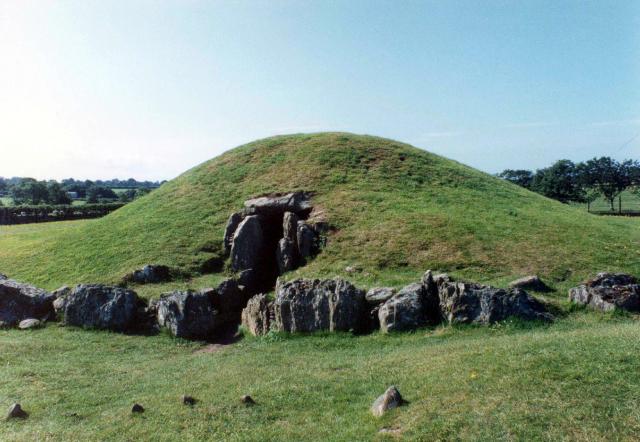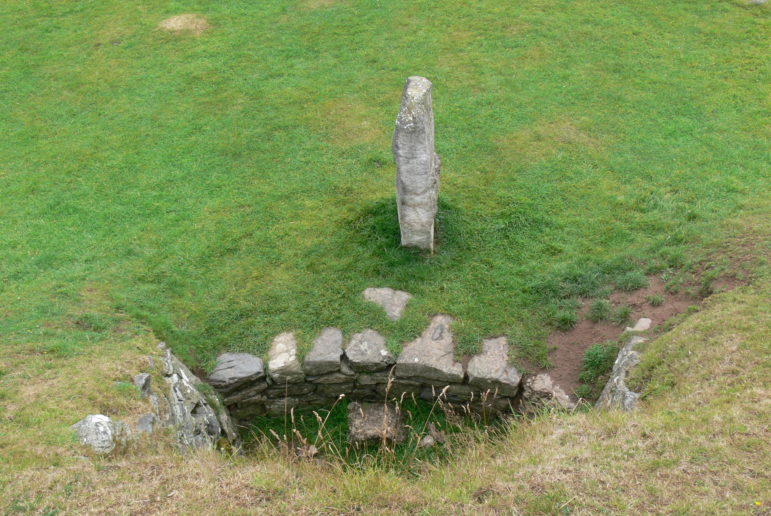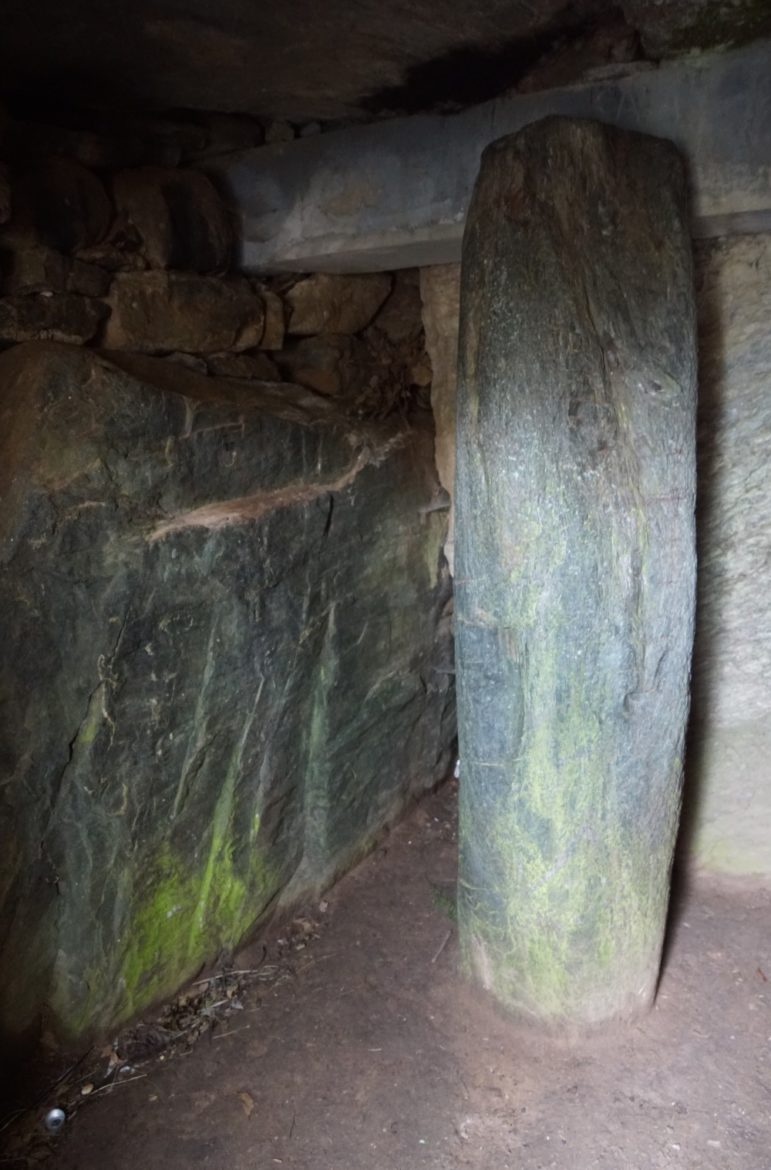ANGLESEY, Wales – Archaeologists are excavating a 4,000-year-old burial mound on the Isle of Anglesey. Their work revealed a Bronze Age burial mound that was built around 500 to 1,000 years after the nearby Neolithic passage tomb of Bryn Celli Ddu.
Bryn Celli Ddu is considered 500 years older than Stonehenge.

Bryn Celli Ddu “The Mound in a Dark Grove” – Image credit: Paul Allison
With the discovery of this new burial mound, the Bryn Celli Ddu site (the Mound in the Dark Grove) is back in the archeological spotlight with its newly discovered neighbor. Bryn Celli Ddu is considered the best-known prehistoric monument on Anglesey.
Bryn Celli Ddu was first discovered in 1865 and later excavated around 1928 and 1929. The reconstruction restored a complete passage into the center of the burial chamber, not the chamber itself. Inside the mound, there is a pillar that has puzzled researchers that has a serpentine pattern that winds around both sides of the stone. Also, the entrance to the burial chamber lines up with the Summer Solstice so that the chamber is illuminated on that day.
Bryn Celli Ddu was originally a henge which is a central stone circle similar to the more famous Stonehenge, but the cairn which is a passage grave, was built up on top of the henge. It is considered one of the last megalithic tombs built on Anglesey.
The initial work on the newly discovered burial mound leads archeologists to believe it to be possibly bigger than Bryn Celli Ddu.

Bryn Cellie Ddu, south-west side: Decorated stone in front of the back of chamber (seen from the top) – Image credit: Wolfgang Sauber
The mound is about 150 feet from Bryn Calli Ddu and according to Dr. Ffion Reynolds, this shows that Bryn Celli Ddu was a “special location” that suggests “that Bronze Age people are coming back to the same location as their Neolithic ancestors and adding their own mark to the landscape.”
Dr. Ffion Reynolds is an archaeologist for the University of Cardiff and also works for the Welsh heritage group, Cadw. She believes with the new cairn being so close to well-known historical site that “This suggests that Bryn Celli Ddu has been a special ceremonial location for thousands of years” as she told Live Science.
Human bones (some intact and some burnt), flint arrowheads, a stone bead, Neolithic pottery, the remains of a stone axe, and shells were found in the passage to the cairn. Researchers are hoping with these items and other scientific tools, they will be able learn more about the people who used the cairn.
With the addition of the cairn, it is believed that Bryn Celli Ddu is the center of an important Bronze Age and Neolithic Age hub. Whether it is of a spiritual nature or a central location for the ancestors who lived there to meet up or settle down around remains to be seen.
History of Anglesey and the Druids
Anglesey, located off the northwest coast of Wales on the Irish sea, is historically known as a seat of power for the British Druids.
In the Annals of Tacitus, Tacitus writes about his experiences on the war campaign against the Britians in the Roman attack on Anglesey by Roman General Gaius Suetonius Paulinus in their attack on the Druids and their sacred sites:
On the shore stood the opposing army with its dense array of armed warriors, while between the ranks dashed women, in black attire like the Furies, with hair dishevelled, waving brands. All around, the Druids, lifting up their hands to heaven, and pouring forth dreadful imprecations, scared our soldiers by the unfamiliar sight, so that, as if their limbs were paralysed, they stood motionless, and exposed to wounds. Then urged by their general’s appeals and mutual encouragements not to quail before a troop of frenzied women, they bore the standards onwards, smote down all resistance, and wrapped the foe in the flames of his own brands. A force was next set over the conquered, and their groves, devoted to inhuman superstitions, were destroyed. They deemed it indeed a duty to cover their altars with the blood of captives and to consult their deities through human entrails.
The women in the description very well could have been female Druids and not only male Druids as Tacitus believed. When the Romans interacted with the Celts, the Romans were a patriarchal society whereas the Celts respected women as equally they did the men until Roman rule came to be more of the norm. Women could be war leaders such as Boudicca who led an attack that destroyed the first British capital just as the Romans attacked the Isle of Anglesey in Tacitus’s description. News of Boudicca’s attack would pull the Roman forces away from Anglesey after killing the Druids who were trying to defend the isle with magic.
Julius Caesar does describe the Druids of old as known to be healers, scholars, doctors, judges, as well as diviners and astrologers in his writing.
Kristopher Hughes, the Chief of the Anglesey Druid Order, has this to say about the Druid order’s involvement with the historic location:
Bryn Celli Ddu is the site that we, as the Anglesey Druid Order, host our civic rituals for the Solstices. We work closely with Cadw, the Welsh Government heritage agency to host open days and other events at the monument.
The Anglesey Druid Order work closely with CADW during the Summer Solstice event, which includes a dawn ceremony and a archaeology open day on the nearest Saturday. The Order and its members have also been active in the Bryn Celli Ddu Community Archaeology Projects, now in its 5th year. This project has brought to light many of Bryn Celli Ddu’s surrounding structures, implying that the site sits within a much larger monument landscape.
We are able to witness the sunrise phenomena in the same manner that our ancestors did, over 5 thousand years ago. Bryn Celli Ddu is not perceived as a relic, she is a living monument, who adapts herself to the needs of the people, spanning a dizzying amount of time. We consider ourselves to be in community with Bryn Celli Ddi. Uniquely, we are the only Druid Order in the UK who officially host a public Solstice ritual at an ancient British monument.
The local people of Anglesey have embraced the fact that the Druids are there for each of the solstices, and many of them will attend. With numbers often swelling to several hundreds of participants.
Bryn Celli Ddu connects us to the ancestors of Ynys Môn, we feel a deep sense of connection to the past here, where we honour our ancestors and the structure that they built.
During the Archaeology Open Day, the Anglesey Druid Order is present to chat to folk about the spiritual significance of the site to modern Pagan practitioners. The day is exceptionally well attended with over 700 visitors in 2019.

Burial chamber – Byrn Celli Ddu – Image credit: By Otter
With the sun lighting up the chamber at Summer Solstice, it is possibly believed that the sun would enter the chamber and warm the spirits of the ancestors so that they would be reincarnated or some other social or religious message in the design of the passage tomb. Other cairns have been found to line up with important sun times such as the Winter Solstice which is believed to help bring warmth and life to the earth to start it waking up again.
With the new work soon finishing up on the cairn, it could become another important place for spiritual pilgrimage by those seeking connection to their Brythonic roots, even more so than Stonehenge.
The Wild Hunt is not responsible for links to external content.
To join a conversation on this post:
Visit our The Wild Hunt subreddit! Point your favorite browser to https://www.reddit.com/r/The_Wild_Hunt_News/, then click “JOIN”. Make sure to click the bell, too, to be notified of new articles posted to our subreddit.